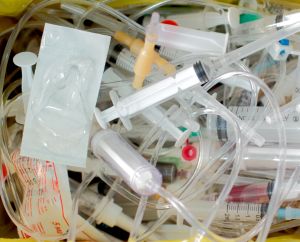At
Wiicare, we understand
the delicate balance our packaging solutions must consistently deliver to our
customers – protecting medical devices while providing end-users a
frustration-free experience with accessing the products. However, a significant
challenge remains: how do you safely and properly dispose of the plastic
packaging after the device is used?
This article dives into the complexities of healthcare
packaging, the impact of healthcare plastics, the opposition to recycling, and
the common applications best suited for package recycling.

The Complexity of Medical Packaging
Healthcare packaging is inherently complex due to the
stringent requirements it must meet. Packaged devices must endure the
sterilization process, the rigors of transportation, and the variety of
environments ranging from sterile operating rooms to combat field hospitals.
Medical packaging must protect the device and maintain
product sterility throughout the entire process. Every decision, down to the
porosity that allows ethylene oxide (EO) gas to evacuate, must be intentional.
Packaging engineers need to design robust packaging to navigate
a host of challenges:
- Ensuring sterile integrity through transit and shelf life
- Designing for ease-of-opening for caregivers with limited dexterity
- Maintaining high-speed manufacturability without sacrificing quality
Wiicare takes pride in balancing all these requirements, but
we don’t stop there. We’re equally focused on the sustainability of the
solutions we create.
The Plastic Problem in Healthcare
Let’s talk numbers. According to a
2020 report by the Journal of the Royal Society of Medicine, plastics are estimated to account for 30% of all healthcare waste. Of the 5.9 million tons of medical waste generated in the US, 1.7 million tons is estimated to be comprised of plastic.
This is staggering. And it’s why Wiicare is committed to packaging solutions that reduce waste without compromising performance.
Opposition to Recycling Single-Use Medical Device Packaging
Despite the substantial opportunity to recycle plastics in healthcare, efforts to recycle medical device packaging have met opposition, hindering widespread adoption.
Here are the most common barriers we encounter:
-
Contamination Risks: Packaging used in healthcare settings can be contaminated with biological materials, posing health risks and complicating the recycling process.
-
Material Complexity: Medical packaging often consists of multiple layers and types of plastics, making it difficult to separate and recycle.
-
Regulatory Constraints: Strict regulations around medical waste disposal can limit the ability to recycle certain types of packaging.
-
Economic Viability: The cost of recycling medical packaging can be high, and the economic benefits may not always justify the investment.
-
Lack of Infrastructure: Many healthcare facilities lack the necessary infrastructure to effectively collect and process recyclable materials.
Despite these realities, there’s good news ahead.
Opportunities for Recycling
Medical Device Packaging
A
white
paper from the Healthcare Plastics Recycling Council (HPRC) states that
nearly 85% or more of plastic waste in US healthcare facilities is
non-infectious and can be separated and remain uncontaminated.
According to
Samantha Smith,
Global Sustainability Strategy Leader and a respected voice in the medical
device industry, “most packaging is going to be non-contaminated until they
throw it into the same bin as they throw a bloody device. When you set up a
sterile field, unless it’s an emergency, the nurse or scrub tech is setting up
the sterile field well before the patient gets in the room and can dispose of
the packaging before there is any chance for contamination. I think there’s very limited risk.”
There are certainly opportunities within healthcare where
medical device packaging can be optimized with recycle-ready materials, leading
to increased adoption of recycling practices.
Some key opportunity areas include:
- Syringes: Syringes used solely to draw medication from vials or containers, without coming into contact with patients, are generally not exposed to infectious waste.
- Gauze: Gauze used for cleaning or covering minor cuts and abrasions that do not involve exposure to bodily fluids or infectious materials.
- Catheters: Catheters used for non-invasive procedures and diagnostic purposes, such as measuring bladder pressure or monitoring urine output, without direct contact with infectious materials.
- Sterile Fluid Pathway Devices with Protective Barriers: Devices designed with protective barriers to maintain sterility, such as those with Luer caps or spike caps, ensuring no exposure to infectious materials.
- Gloves: Sterile gloves used for administering subcutaneous or intramuscular injections, handling sterile instruments during the setup of surgical trays, or diagnostic procedures where the gloves maintain sterility without direct contact with infectious materials.
Partnering with the Right Packaging Supplier
During her tenure with a global medical device manufacturer,
Samantha Smith valued packaging suppliers who were in tune with the changing
landscape and had the ability to offer innovative solutions.
“Packaging suppliers need to understand what it takes to
design a medical package, not just structurally, but the sterilization testing,
transit testing and quality validations. Working with the medical device
manufacturer to understand their needs and potentially going directly to
hospitals to identify their circularity needs is also very important. Keeping up with regulations that may come
into play and impact packaging offers tremendous value to customers,” said
Smith.
How Wiicare is Leading the Charge
As a proud member of the Healthcare Plastics Recycling
Council, Wiicare is at the forefront of developing materials that are not only
functional and protective but also recycle-ready.
Our R&D teams are exploring ways to simplify material
compositions, enhance recyclability, and support circularity goals across the
healthcare industry.
By addressing these challenges and opportunities, Wiicare
aims to lead the way in sustainable healthcare packaging solutions, ensuring
both protection for medical devices and a positive impact on the environment.
Interested in learning more?
Contact us to explore how our
innovations can support your sustainability goals.
REFERENCES:
Plastics in healthcare: time for a re-evaluation, Journal of the Royal Society of Medicine, 2020 Feb 7
How Sustainable Plastics are Improving the Healthcare Industry, PlasticsIndustry.org, 2025 Feb 10
Healthcare Plastics: Guidance for Recyclers, Healthcare Plastics Recycling Council (HPRC), 2019
Samantha Smith, Global Sustainability Strategy Leader, LinkedIn profile

Author
Don Alip
Product Manager, Healthcare
Sauk Village, IL
don.alip@winpak.com
Submit a comment